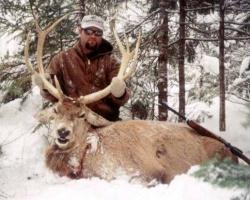The single shot was sharp and clean. Ten-year-old Gregory Cabral’s bullet found its mark, and his snorting prey collapsed, dead, in the thick Maine woods.
But this was no ordinary animal. And it was no ordinary hunt.
Cabral shot a hairy Russian boar inside the Hillside Game Ranch, 400 acres enclosed by a 6-foot wire fence in this speck of a town between Bangor and Calais. It is one of 11 big-game shooting preserves that operate with little notice in northern New England, drawing people with the promise of killing a European red stag, say, or American buffalo, held within the compound.
For the privilege of killing two boars, Cabral’s father and grandfather paid $1,200. By their reckoning, that gets them enough bacon, pork chops, and ham to last their families nearly a year.
“I see it like I’m going grocery shopping,” said Russell Mulgrew, Cabral’s grandfather.
Not everyone shares that view. Opponents, including some hunters, say captive hunting is anything but sporting for one simple reason: There is no fair chase when the animal has no hope of escape.




